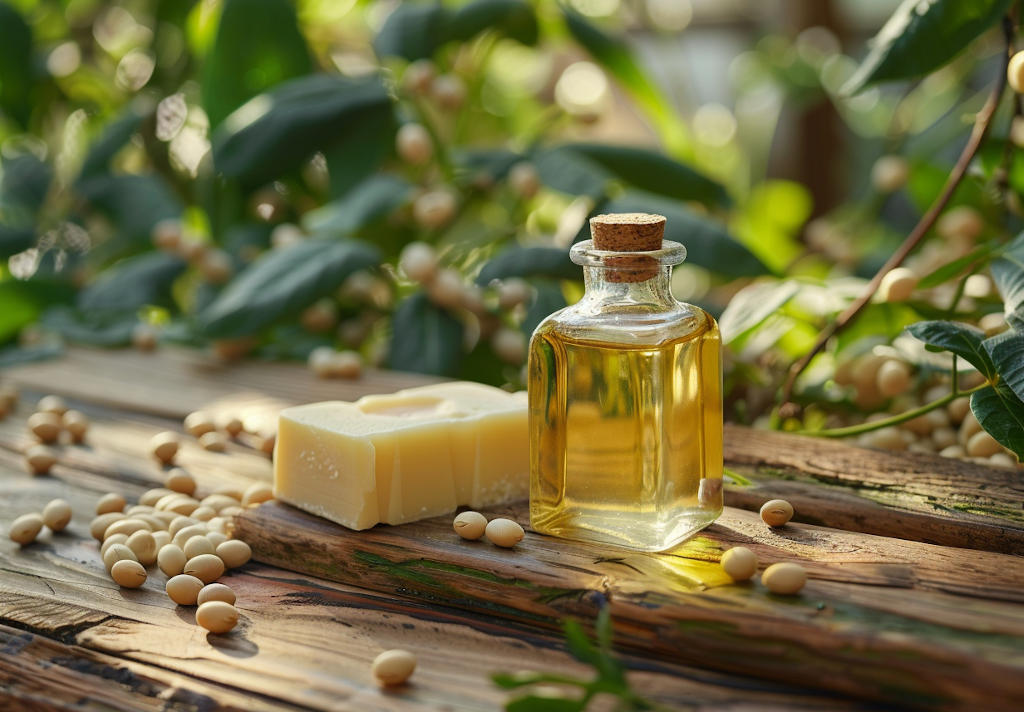Refined Soybean Oil
2,21 € – 9,08 €
“Rich in essential fatty acids such as linoleic acid (omega-6) and oleic acid (omega-9), soybean oil intensely nourishes and deeply moisturizes the skin. It promotes skin suppleness while adding natural softness to your soaps. Inexpensive and versatile, it’s an oil to discover for saponification, but also for all your home cosmetics: day creams, massage oils, and much more.”
Soybean oil moisturizes, softens and protects the skin, soothing irritation and preserving its natural balance. Too often underestimated, it is a gentle and effective alternative to include in your soaps for a unique sensation of comfort and well-being. Perfect for professional soap-makers in search of innovation, it enriches your creations while meeting the expectations of sensitive skin.
- Antioxidant: It's rich in vitamin E, a powerful antioxidant that helps protect the skin against damage caused by free radicals. It therefore helps prevent premature skin aging.
- Anti-inflammatory: Thanks to its anti-inflammatory properties, soybean oil can help soothe skin irritation, redness and inflammation, making it a beneficial ingredient for sensitive or irritation-prone skin.
- Skin hydration: Soybean oil is rich in essential fatty acids, such as linoleic acid and oleic acid, which help maintain skin hydration and strengthen the skin barrier.
- Improved skin elasticity: By penetrating deep into the skin, soybean oil can help improve elasticity, reduce the appearance of fine lines and wrinkles, and give skin a firmer, more toned appearance.
- Nourishing for hair: When used on hair, soybean oil nourishes and moisturizes hair follicles, which can help strengthen hair, reduce frizz and improve shine and softness.
Recommended for which skin type :
- For normal to dry skin: Rich in essential fatty acids, it provides deep hydration and helps restore the skin barrier. It is therefore ideal for keeping skin supple and soft.
- For mature skin: the unsaponifiables present in soybean oil have anti-aging properties, helping to prevent the appearance of fine lines and wrinkles while maintaining skin elasticity.
- For sensitive skin: Its light, soothing texture is also suitable for sensitive skin, soothing irritation and redness while providing gentle, non-irritating hydration.
- For acne-prone skin: Although it may be comedogenic for some people, it can be used with caution to moisturize acne-prone skin, due to its moisturizing and soothing properties.
- For combination skin: Lightweight and non-greasy, it is also suitable for combination skin, providing balanced hydration without clogging pores.
Tips and Tricks for the Soap Maker :
The unsaponifiables in Soybean Oil:
- Vitamin E (tocopherols): A natural antioxidant, vitamin E helps protect cells against damage caused by free radicals. In soap, it can help extend shelf life by preventing the rancidity of oils.
- Sterols (beta-sitosterol, campesterol, stigmasterol):
- Beta-sitosterol: Has anti-inflammatory properties and can help soothe irritated skin.
- Campesterol: Helps reduce skin inflammation and may assist in the treatment of skin conditions such as eczema.
- Stigmasterol: Has similar properties to other sterols, helping to reduce inflammation and offering moisturizing benefits.
- Phytosterols: Improve skin elasticity, promote skin barrier repair and help moisturize the skin. Phytosterols may also have anti-aging effects, due to their ability to promote moisture retention and improve skin structure.
- Squalene: Although present in smaller quantities in soybean oil, squalene is an excellent emollient. It helps maintain skin hydration and is quickly absorbed without leaving a greasy feel.
Its saponification value :
The saponification value of soybean oil is 190, which means that 0.190 g of NAOH soda (Link to soda lye or soda pearl) are needed to saponify 1 g of soybean oil. This information will help you calculate your own recipe.
In your calculator, choose "Soya Oil" or "Huile de soja".
It is an unstable oil, and its content in your recipe should be between 5% and 15% maximum.
Tips :
Mix soybean oil with other skin-friendly oils, such as olive oil or coconut oil, to create a balanced, nourishing soap..
Use soybean oil in moderate quantities (10-15% maximum).
Too much oil can lead to an over-greasy soap that may be more susceptible to rapid oxidation.
If you want to increase the lather of your soap, you can add ingredients such as sugar or honey to the trace (at the end of the process). This will help create a more abundant, luxurious foam (2% or 3% of the total weight of the oils).
Additions / Superfatting:
Add natural antioxidants (such as vitamin E) to your recipe to help prevent oxidation and extend the life of your soap.
Soybean oil generally produces a light to medium trace during cold saponification. This means that when you mix the oils with the lye, the trace, which is the consistency of the mixture, will be fluid sooner. A light to medium trace generally makes it easy to work the soap paste, pour it into molds and create designs if desired (One Pot marbling technique recommended).
Directions for use for solid shampoo and conditioner:
The properties of soybean oil used in solid shampoo and conditioner recipes:
- Emollient: Soybean oil softens and smoothes hair, making it easier to detangle and style.
- Moisturizing: Thanks to its ability to retain moisture, it keeps hair hydrated, making it softer and more supple.
- Nourishing: The essential fatty acids found in soybean oil deeply nourish hair, helping to strengthen it and protect it from damage.
- Scalp balancer: regulates sebum production in the scalp, helping to balance oily hair and soothe itching.
- Fortifying: It strengthens the hair fiber, reducing breakage and split ends, while promoting hair growth.
- Protective: The antioxidants present in soybean oil protect hair from damage caused by external aggressors, such as pollution and UV rays.
Composition of soybean oil:
- Monounsaturated fatty acids :
- Gadoleic acid: 65.0 - 90.0
- Erucic acid: 5.0 - 30.0
- Oleic acid: 5.0 - 15.0
- Saturated fatty acids :
- Nervonic acid: 0.5 - 5.0%.
- Other active ingredients :
- Unsaponifiables: These compounds are renowned for their protective action on the skin and their ability to combat skin aging.
Which mould to use?
Be aware that the reaction between soda and oils can generate heat. Use our molds for this purpose, and monitor the temperature throughout the process to avoid the freezing phase in your soaps. These molds are flexible, making them easy to remove from the mold once the soap has hardened.
What's more, they enable better heat retention during the saponification process, promoting optimal soap setting.
How to store soybean oil :
- Store in a cool, dry place away from direct sunlight.
- Make sure it's securely closed.
- It generally keeps for up to 12 months after opening.
Illustration photo
The indications and advice given above are provided for information purposes only, based on reputable sources in aromatherapy, soap-making and phytotherapy.
They should in no way be considered as medical advice.
It is not a substitute for professional medical advice, diagnosis or treatment.
It is essential to consult a health professional before using essential oils or any other product mentioned.
Furthermore, please note that the product discussed in this context is not intended for consumption.
Additional information
| Weight | 1050 g |
|---|---|
| Origin | China, Asia |
| Contenance | 100ml, 250ml, 500ml, 1L |
Only logged in customers who have purchased this product may leave a review.









Reviews
There are no reviews yet.